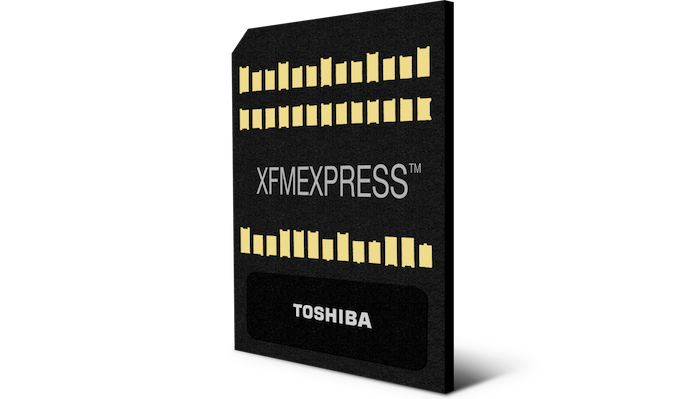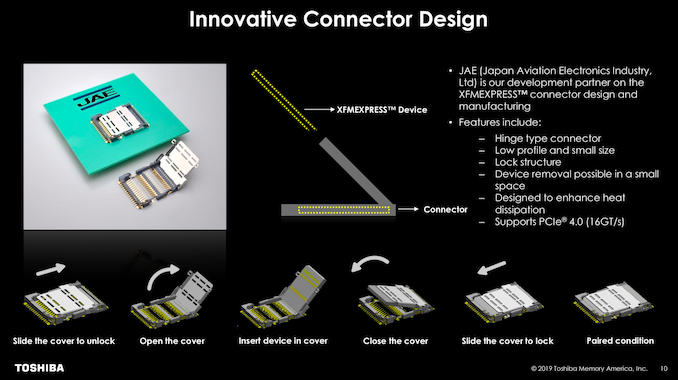Toshiba Introduces New Tiny NVMe SSD Form Factor
by Billy Tallis on August 6, 2019 8:00 AM EST
Today at Flash Memory Summit, Toshiba is debuting a new form factor for NVMe SSDs that is small enough to be a removable alternative to soldered-down BGA SSDs. The new XFMEXPRESS form factor allows for two or four PCIe lanes while taking up much less space than even the smallest M.2 22x30mm card size. The XFMEXPRESS card size is 18x14x1.4mm, slightly larger and thicker than a microSD card. It mounts into a latching socket that increases the footprint up to 22.2x17.75x2.2mm. For comparison, the standard sizes for BGA SSDs are 11.5x13mm with a PCIe x2 interface or 16x20mm with a PCIe x4 interface.
XFMEXPRESS is intended to bring the benefits of replaceable storage to devices that would normally be stuck with soldered BGA SSDs or eMMC and UFS modules. For consumer devices this opens the way for aftermarket capacity upgrades, and for embedded devices that need to be serviceable this can permit smaller overall dimensions. Device manufacturers also get a bit of supply chain flexibility since storage capacity can be adjusted later in the assembly process. XFMEXPRESS is not intended to be used as an externally-accessible slot like SD cards; swapping out an XFMEXPRESS SSD will require opening up the case of the device it's installed in, though unlike M.2 SSDs the XFMEXPRESS socket and retention mechanism itself is tool-less.
XFMEXPRESS will allow for similar performance to BGA SSDs. The PCIe x4 host interface will generally not be the bottleneck, especially in the near future when BGA SSDs start adopting PCIe gen4, which the XFMEXPRESS connector can support. Instead, SSDs in these small form factors are often thermally limited, and the XFMEXPRESS connector was designed to allow for easy heat dissipation with a metal lid that can serve as a heatspreader. Toshiba partnered with Japan Aviation Electronics Industry Ltd. (JAE) to develop and manufacture the XFMEXPRESS connector.











28 Comments
View All Comments
ikjadoon - Tuesday, August 6, 2019 - link
Is Toshiba pitching this to PCI-SIG, who controls the M.2 specification? Why not add it to M.2, instead of positioning it as an alternative?Because...why would system OEMs ever design for a tiny (in market share), brand-new form factor for SSDs? Why would SSD manufacturers re-create their M.2 SSDs? How will customers find these things available at retailers? What's the point of being able to replace your SSD, if manufacturers aren't making them?
Trying this "we're a big company...let us just shoehorn our own form-factor and see how the market responses" seems ridiculous in 2019. Just make it a standard: we don't need less interoperability in this dwindling market
ikjadoon - Tuesday, August 6, 2019 - link
*respondsBilly Tallis - Tuesday, August 6, 2019 - link
When Toshiba briefed me on this before the show, they wouldn't answer any questions about whether the spec would be open, etc. I'm not sure if they've even decided for sure how to handle ownership of this standard. I don't seeing it having much success in the market unless they make it royalty-free and contribute it to a standards body.ikjadoon - Tuesday, August 6, 2019 - link
Eghad: Toshiba, be smart.Thank you for following up with them after Toshiba dropped this: Toshiba should know people are very curious and it doesn't reflect well for all this R&D to be stuck in a halfway-open/halfway-proprietary dead man's zone: not for consumers, not for the industry, and unfortunately not for Toshiba, either. They can take a look at Thunderbolt 3 for a live case study.
I agree. We all want this tech to proliferate: standards are the only serious shot to do that, in this industry.
Cheers, Mr. Tallis. Let's hope the next release from Toshiba is their integration into M.2, at least!
sorten - Tuesday, August 6, 2019 - link
"I'm not sure what this actually offers vs smaller form factors in the m.2 spec?"This post is only 3 paragraphs.
Mobile-Dom - Tuesday, August 6, 2019 - link
I actually kinda love htisPeachNCream - Tuesday, August 6, 2019 - link
So cool! If they fit within the power consumption and thermal limits of mobile platforms, these would maybe offer a nice performance boost for removable storage over SD-based standards.MojArch - Tuesday, August 6, 2019 - link
This might actually happen cause big excuse for manufacturers was that micro SD is slow and therfore no need to implement it!PProchnow - Tuesday, August 6, 2019 - link
I like it but I cannot FB like it.I miss the "HOW FAST" part.
PProchnow - Tuesday, August 6, 2019 - link
I was thinking like all the Surface like devices that could spin off with real fast large SSDs. If they build enough and the higest performance CellPhone CPUs get reasonable there will be really tremendous low power hi-out put computing to be done. I would really like a better Amazon Fire device ASAP for shopping as an example with great multi-tasking capability. Oh wait. That is a browser issue with the Fire, sorry.